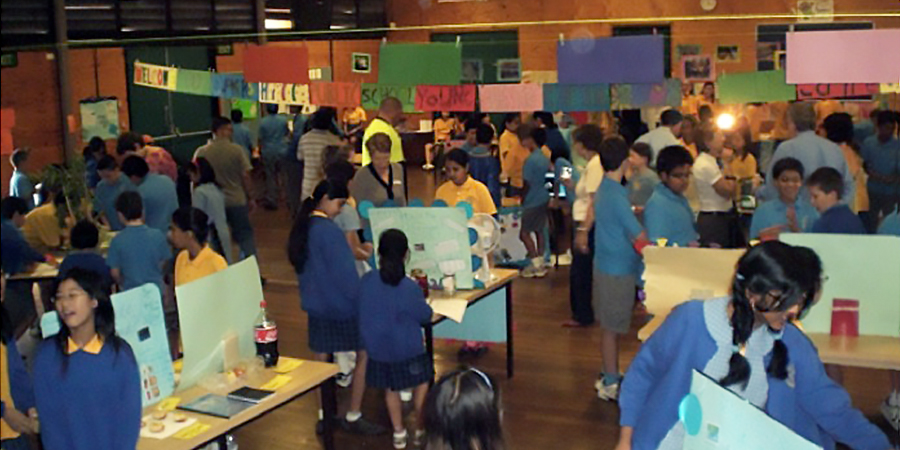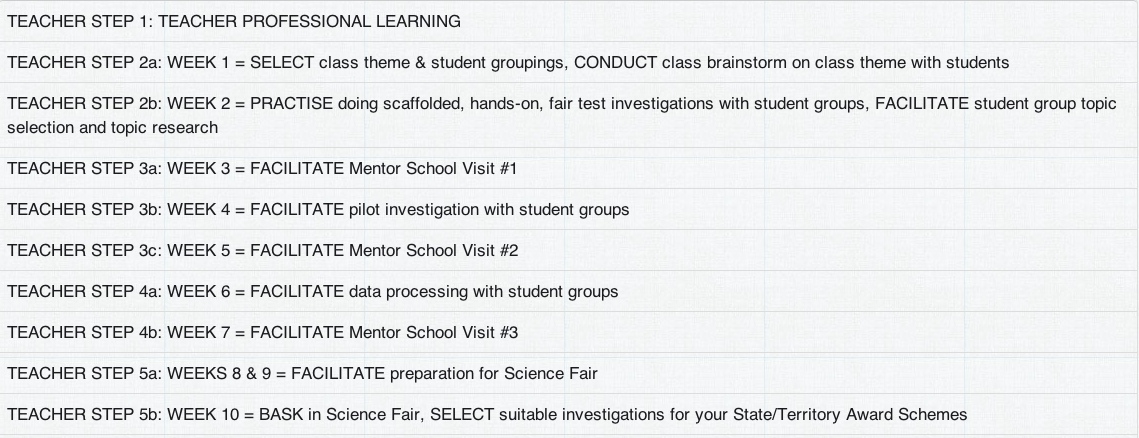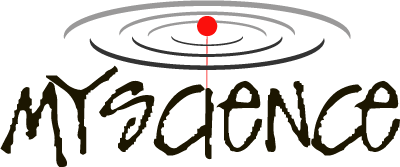TEACHER STEP 5
STEP 1
Professional Learning & Preparation
STEP 2
Phase 1 – High Direction
STEP 3
Phase 2 – Mentored Exploration
STEP 4
Phase 3 – Independence
STEP 5
Presentation & Celebration

Goals for STEP 5
- Bring closure for students by revisiting the ORIGINAL BRAINSTORM
- Have student groups EVALUATE their collaborative skills
- Facilitate student groups to PREPARE a written REPORT, and a suitable method for communicating their findings at a Science Fair
- Facilitate student groups to SHARE their findings with the class
- Contact LOCAL MEDIA to attend the Science Fair
- Facilitate the preparation for and implementation of a SCIENCE FAIR
- Select suitable STUDENT INVESTIGATIONS for your State/Territory Award Scheme
Scroll down for more information.
STEP 5 – Plan Ahead
- ORIGINAL BRAINSTORM: revisit
- EVALUATE SKILLS: student groups
- PREPARE REPORT: student groups
- SHARE FINDINGS: student groups
- LOCAL MEDIA: contact about Science Fair
- SCIENCE FAIR: conduct
- SELECT REPORTS for Award Schemes
STEP 5 covers WEEKS 8, 9 & 10 of Implementation

STEP 5 – Information
Revisit Original Brainstorm
- To complete the learning cycle students need to return to the initial brainstorm/mind map of the theme into topics from STEP 2. Revisiting the original brainstorm demonstrates to students how far their knowledge and understandings have developed related to the theme.
- See Resource Button: ‘5.1 Revisit Original Brainstorm’ for more information.
Evaluate Collaborative skills
- Now is a good time for students to evaluate their collaboration skills.
- Resource Button ‘5.2 Evaluate Group Skills’ contains an exercise for students to do.
Prepare Report
Information about the STRUCTURE of an Investigation Report can be found at ‘5.3 Investigation Report’.
Resources to scaffold students in preparing their report are in STEP 3:
- ‘3.7 Student Scaffold: BASIC’
- ‘3.8 Student Scaffold: ADVANCED’
If these scaffolds have been used then producing a written report will be much easier.
Share Findings With Class
- Students (and you) have been learning about ‘Working and Thinking Scientifically’ through membership of a COMMUNITY of SCIENCE PRACTICE related to the class them.
- WIDENING and CONNECTING student learning will occur when groups SHARE what they have found through their investigations.
- PRESENTING to colleagues serves as a REHEARSAL for the SCIENCE FAIR. The written report -required for Award Schemes- will need to be adapted to suit audience needs such as developing a POWERPOINT, which can be used alone and/or slides can be printed and used on a POSTER.
- The following ‘Resource Buttons’ provide examples of ways that findings can be shared:
- ‘5.4 Year 1-2 Scaffolded Report’
- ‘5.5 Year 3-4 Powerpoint Slides’
- ‘5.6 Year 4-5 Written Report’
- ‘5.7 Year 6 Written Report’
- ‘5.8 Year 5-6 Poster’
Local Media
Make sure that you invite local media outlets to attend the School Science Fair. It is in their and your interests to cover events such as SCHOOL SCIENCE FAIRS because:
- students are actively engaged in presenting their findings, which presents great photo opportunities,
- attendance by local community members presents opportunities for interview comments, while profiling the newspaper/TV station,
- coverage raises the profile of your school and of SCIENCE EDUCATION in the local community,
- local businesses may have employees with science expertise who could volunteer as Mentors,
- local community members with science expertise may volunteer as Mentors.
Science Fair
A Science Fair provides a way for students to celebrate their learning. It is the FIFTH KEY ELEMENT of the MyScience Educational Model.
A range of listeners can be invited to participate such as:
- other students (of all ages)
- parents and local community members
- local primary school teachers
- local secondary school science teachers
Students should have been alerted early in the process of their investigation (Teacher Step 2: Resource ‘2.7 Student Weekly Sequence’) about the Science Fair and consequently should have collected a range of data, images and equipment that can be used at a ‘stall’ to support their explanations.
Resource ‘5.9 Science Fairs’ provides information about the many benefits for students of participating in a Science Fair.
Resource ‘5.10 Students Explaining’ is a video of some students explaining their results of an investigation into the impact of different types of motivation in sport at their school Science Fair.
Resource ‘5.11 Actual Science Fair’ is a short video of a Science Fair set up in a School Hall.
Awards Schemes
- All Australian States and Territories have Science Teaching Associations (STA) who run Award Schemes associated with Scientific Investigations. STA websites can be accessed through the AUSTRALIAN SCIENCE TEACHERS’ ASSOCIATION (ASTA) website at ‘5.12 ASTA Website’.
- Winners at STATE LEVEL are forwarded to the NATIONAL BHP Billiton Awards – see ‘5.13 BHP Billiton Awards Website’
- Within NSW the Science Teachers’ Association of NSW (STANSW) runs the YOUNG SCIENTIST AWARDS – access via ‘5.14 STANSW YS Awards Website’.
- We have used the Young Scientist Awards MARKING RUBRIC as an assessment guide for MyScience in the TEACHER INFORMATION page. It is also available on this webpage via Resource ‘5.15 Young Scientist Rubric’.
And Finally…
CONGRATULATIONS for completing MyScience. Hopefully you and your students have learned more about what it means to be Working and Thinking Scientifically.
Please send us ideas, resources, suggestions via ‘Contact Us’ as we continue to develop and evolve the program.
